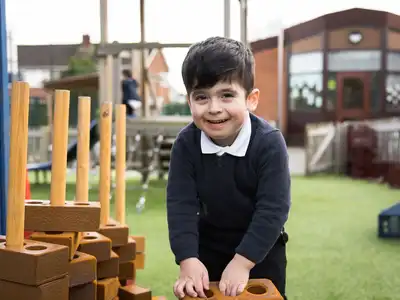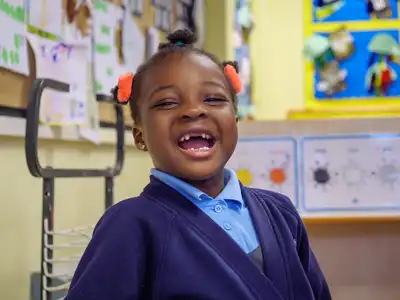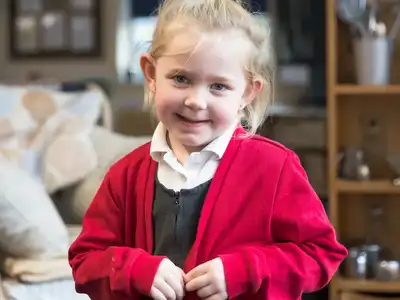As a primary headteacher or early years leader, you shape not only what children learn, but how they learn. The characteristics of effective teaching and learning are central to this process.
What are the characteristics, and why do they matter for the quality of your early years provision? This article explores where these characteristics come from, what they look like in practice, and how understanding them can help you lead confident, curious learners across your school. Plus, we share how one early years setting brings them to life every day.
This article is part of a series exploring the four overarching principles of the early years foundation stage: the unique child, positive relationships, enabling environments, and learning and development.
What are the characteristics of effective teaching and learning?
The characteristics of effective teaching and learning have formed part of the early years foundation stage statutory framework since 2012 (Department for Education, 2024). Building on long-standing principles of play-based education, Dame Clare Tickell’s independent review (2011) recommended that the framework make explicit how children learn - through exploring, persisting and making sense of their experiences - which “begin at birth and are lifelong characteristics which need to be fostered”.
These characteristics offer a shared language for practitioners to recognise and nurture each child’s curiosity, motivation and critical thinking as they engage with the world around them.
The three characteristics are:
Playing and exploring – how children engage with experiences, show curiosity, and are willing to ‘have a go’.
Research shows that when children choose activities and learn through first-hand experience, they build understanding through action and interaction. Rich, playful experiences help children adapt, collaborate and think creatively (Bruce, 2001). In high-quality settings, practitioners give children space to explore while stepping in at the right moments to extend their thinking. This balance encourages curiosity, persistence and flexible thinking, behaviours that strengthen learning across the curriculum (Siraj-Blatchford et al., 2002).
Active learning – how children stay motivated, sustain effort, and keep trying when things are tricky.
Learning is an active, social process in which children build understanding through action, talk and reflection within a supportive environment (Siraj-Blatchford et al., 2002). In high quality settings, practitioners plan environments and experiences that encourage children to take initiative and persevere with new challenges. By helping children stay focused and take pride in their efforts, practitioners help them develop the confidence to keep going when things are tricky (Sylva et al., 2014; Ofsted, 2023).
Creating and thinking critically – how children make connections, solve problems, and reflect on what they’ve learned.
Young children are curious thinkers. They make sense of experiences by noticing patterns, building concepts and testing ideas (Evangelou, 2009). Practitioners in high quality settings give children time to plan, make choices and explain their reasoning. These opportunities help children develop early metacognitive skills – awareness of how they think and learn (Whitebread & Pasternak, 2010). Experiences like these support children in developing flexible thinking and problem-solving skills, which are linked to later success in learning and self-regulation (Ofsted, 2023).
By embedding these behaviours, you help every child develop a sense of their own capacity to be a successful learner (Pascal & Bertram, 2021), building the confidence, curiosity, and motivation that underpin progress across the curriculum.
How to support your early years team
Here are some practical ways to help your team embed the characteristics of effective teaching and learning:
Foster a culture that values how children learn
Talk with your staff about the importance of how children learn as well as what they learn. Focus professional discussions on children’s engagement, motivation and curiosity. Encourage your staff to be intentional in how they use play, the environment and everyday experiences to deepen thinking and extend learning.
Focus on quality of interactions
High quality interactions make the biggest difference to children’s learning. Support staff with professional development on approaches such as sustained shared thinking. Encourage practitioners to reflect on when to step in, when to scaffold, and when to step back to let children take the lead.
Connect early years with the rest of the school
Draw clear links between how children learn in the early years and the expectations that follow. When teachers across phases understand and build on these learning behaviours, they strengthen continuity in teaching and support progress and achievement throughout school.
Case study: Embedding the characteristics in practice
Find out how Dixie-Louise Dexter and Nicola Middleton at Ashby Hill Top Primary School bring the characteristics of effective teaching and learning to life and the difference it makes for children in this case study: How teaching the characteristics of effective teaching and learning in your early years setting improves learning outcomes for all
Questions for staff reflection
Use these questions to evaluate how your setting promotes the characteristics of effective teaching and learning, and to identify practical next steps:
Playing and exploring:
- How well does our early years environment invite children to explore, experiment and follow their own interests?
- When observing children play, do we notice moments of curiosity and engagement, or are some areas of provision underused or overly adult-directed?
Active learning:
- How do we recognise and celebrate children’s effort and persistence?
- How are our routines and expectations supporting children to concentrate, take risks and keep trying when things are tricky?
Creating and thinking critically:
- Where and when do children have regular opportunities to make choices, test ideas and talk about what they notice?
- How do we encourage children to explain their thinking and share different ways of solving problems?
Summary
The characteristics of effective teaching and learning are a core part of the early years foundation stage statutory framework. They set the expectation that schools consider how children learn as well as what they learn. They offer a practical lens for understanding each unique child – how they engage, stay motivated and think critically. By keeping these principles central, you strengthen early years practice, build confident learners, and create a consistent approach to learning that begins in the early years and continues throughout your school.
References
- Department for Education (2024). Statutory Framework for the Early Years Foundation Stage.
- Evangelou, M., Sylva, K., Kyriacou, M.,Wild, M. and Glenny, G. (2009) Early Years Learning and Development Literature Review. DCSF.
- Ofsted. (2023). Best start in life: Part 1 – Curriculum research review. Ofsted.
- Pascal, C., & Bertram, T. (2021). Getting it right in the EYFS: A literature review. Early Education.
- Siraj-Blatchford, I., Sylva, K., Muttock, S., Gilden, R., & Bell, D. (2002). Researching effective pedagogy in the early years (REPEY). Department for Education and Skills.
- Sylva, K., Melhuish, E., Sammons, P., Siraj, I., Taggart, B., & Smees, R. (2014). Students’ educational and developmental outcomes at age 16: Effective Pre-School, Primary and Secondary Education (EPPSE 3–16) Project. Department for Education.
- Tickell, C. (2011). The Early Years: Foundations for life, health and learning. An Independent Report on the Early Years Foundation Stage to Her Majesty’s Government. Department for Education.
- Whitebread, D., & Pasternak, D. (2010). Metacognition, self-regulation and meta-knowing in young children: Review of research for the EYFS review. Department for Education.



